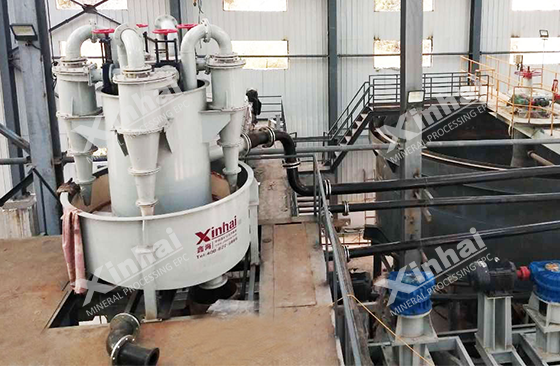
Gravity separation technologies play a vital role in mineral processing plants, providing a cost-effective and environmentally friendly method of concentrating ores. These technologies are essential for the efficient recovery of valuable minerals from ores, improving the overall productivity and benefits of mining operations. In a concentrator, gravity separation methods are methods of separation based on the difference in specific gravity of minerals. The main gravity separation methods used in concentrators today include shakers, cyclones, centrifugal separators, heavy media separation, and spiral concentrators. Each technology has its own unique advantages and is suitable for specific types of ores, making it an indispensable tool in the field of mineral processing. The following article mainly introduces the working principles and applications of these gravity separation techniques.

Shaking table gravity separation method is a mineral separation method based on gravity difference. Its working principle is to use the tilting and shaking motion on the surface of the shaking table to make the ore move in different directions under the action of water flow, thereby achieving mineral separation. The shaking table continuously vibrates, so that the heavier minerals settle below the bed surface, while the lighter minerals stay above the bed surface or flow to the discharge port.
Advantages: high sorting accuracy, strong adaptability, and it can effectively separate fine particles and complex mineral mixtures.
Disadvantages: The processing capacity is relatively low, and the equipment has high technical requirements for operators.
Applicable types of ore: Shaking table is suitable for processing ores with high specific gravity differences, such as gold, tin and chrome, and is particularly suitable for high-precision ore separation and concentration.

Cyclone gravity separation technology uses centrifugal force to separate minerals, separating them according to the differences in ore particle size and density. During operation, the slurry enters the conical separation chamber through the feed port of the cyclone, forming a high-speed rotating centrifugal field. The heavier mineral particles move toward the outer wall under the action of centrifugal force, while the lighter particles are thrown to the center, thus achieving layered separation.
Advantages: It has efficient separation capacity, low equipment and maintenance costs, and strong adaptability, and can handle slurries of different particle sizes.
Disadvantages: There are certain requirements for slurry concentration and particle distribution during gravity separation, and the efficiency may be reduced when processing very fine or very coarse minerals.
Applicable ore types: Cyclones are particularly suitable for processing medium-sized ores, such as iron ore, copper ore, and lead-zinc ore, but may not be effective for very fine or very coarse minerals.

Centrifugal concentrator uses centrifugal force to improve the separation efficiency of minerals. Its working principle is to generate strong centrifugal force through rotation, so that mineral particles are layered in the machine according to density differences, thereby achieving effective separation.
Advantages: It has high separation capacity, ans is able to handle fine-grained ores, and excellent performance in the treatment of complex ores. Centrifugal concentrators can achieve high recovery rates and high-grade ores.
Disadvantages: High equipment cost and sensitive to operating conditions.
Applicable ore types: Centrifugal concentrator is especially suitable for processing ores containing precious or difficult-to-process minerals such as gold, tungsten, lead, zinc, etc., and is particularly outstanding in the treatment of fine-grained ores.
Heavy medium separation is a separation technology based on the difference in specific gravity between ore and medium. Its working principle is to mix ore with a heavy medium with a specific specific gravity (such as magnetite or manganese ore), so that the useful minerals and waste rocks in the ore show different sedimentation behaviors in the heavy medium, thereby achieving effective separation.
Advantages: including efficient separation effect and a good processing particle size range, especially suitable for the processing of large pieces of ore.
Disadvantages: high requirements for heavy media, high equipment and maintenance costs.
Applicable ore types: Heavy medium separation is widely used in the processing of ores with obvious density differences, such as coal, iron ore and copper ore.

The spiral cyclone is a widely used gravity separation equipment, and its working principle is based on centrifugal force and fluid dynamics. Inside the equipment, the slurry rotates along the spiral groove, and the heavy particles are thrown to the groove wall due to the centrifugal force, while the light particles are brought into the central overflow area, thereby achieving the separation of minerals.
Advantages: simple structure, easy operation, and the ability to handle a wide range of particle size distributions, while maintaining a high recovery rate when processing low-grade ores.
Disadvantages: limited processing capacity, and more sensitive to the viscosity and flow rate of the slurry.
Applicable ore types: The spiral cyclone is suitable for separating ores with large density differences, such as iron ore, bauxite and manganese ore. It performs well in the processing of these ores and can effectively improve the grade and recovery rate of the ore.

In summary, various gravity separation technologies have their own advantages and disadvantages in the application of mineral processing. Shaking table technology is suitable for processing ores with high specific gravity differences due to its high sorting accuracy and strong applicability. Cyclones are widely used in medium-sized ore processing due to their efficient separation capabilities and low cost. Centrifugal concentrators perform particularly well when processing fine-grained ores, but the equipment cost is high. Heavy media separation technology is effective in processing large ores, while spiral cyclones are particularly suitable for separating ores with large density differences due to their easy operation and wide range of particle size adaptability. Choosing the right gravity separation technology not only improves ore grade and recovery, but also optimizes the overall efficiency of a mineral processing plant.
To find out more about our products and solutions, please fill out the form below and one of our experts will get back to you shortly.